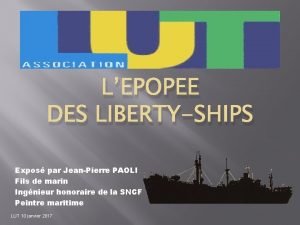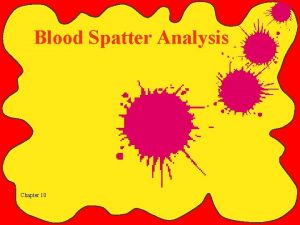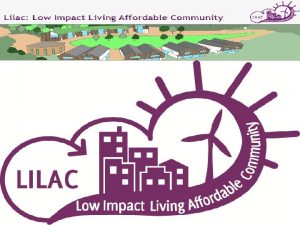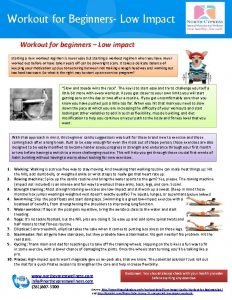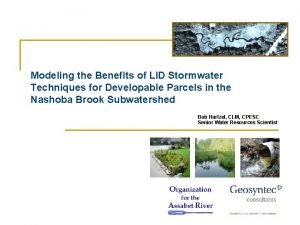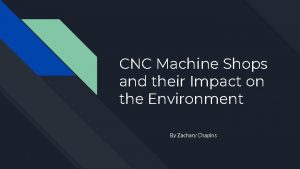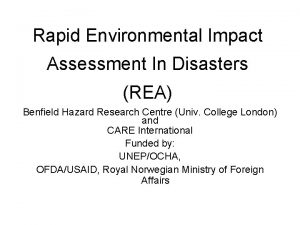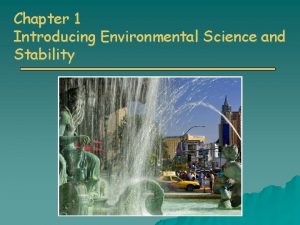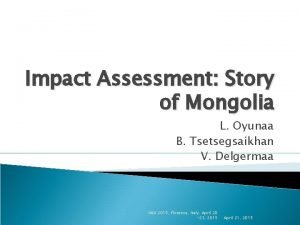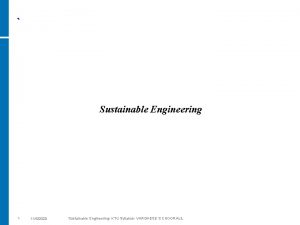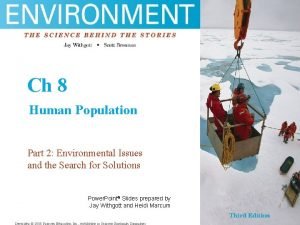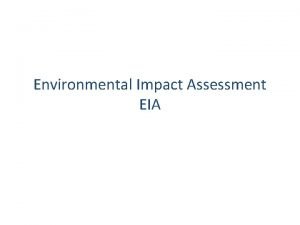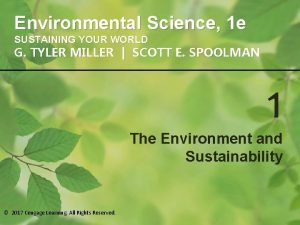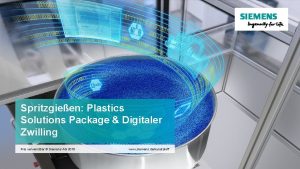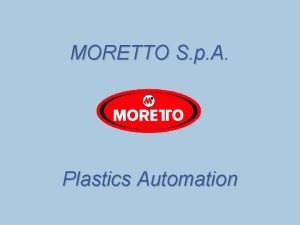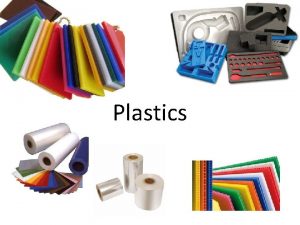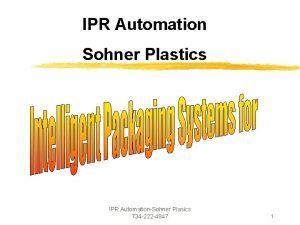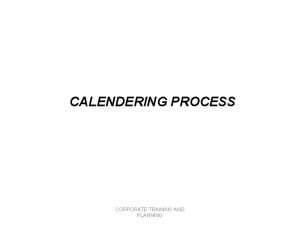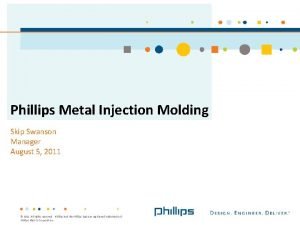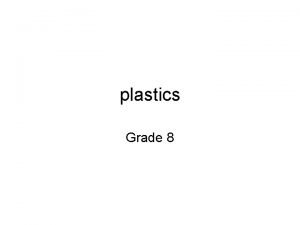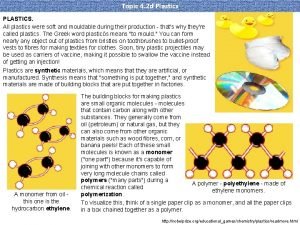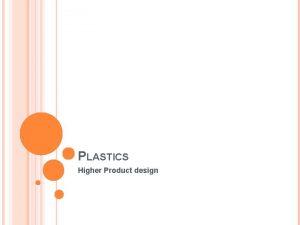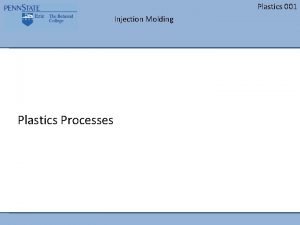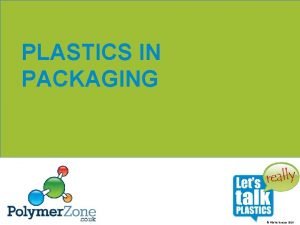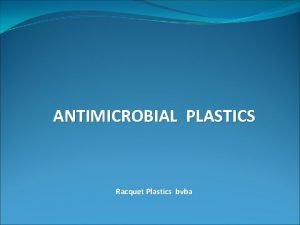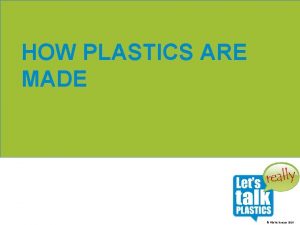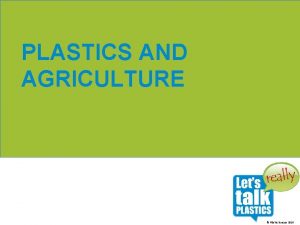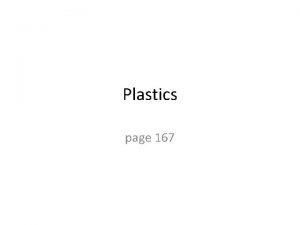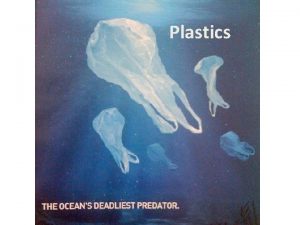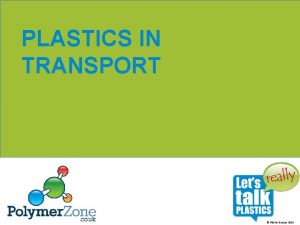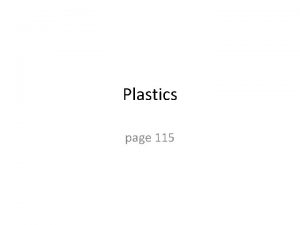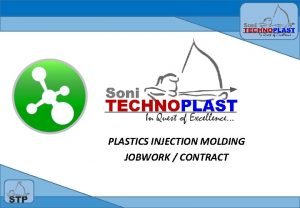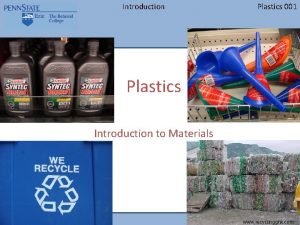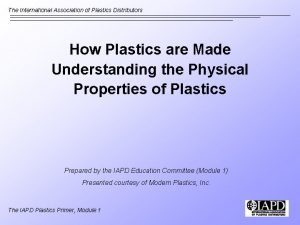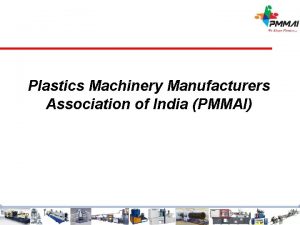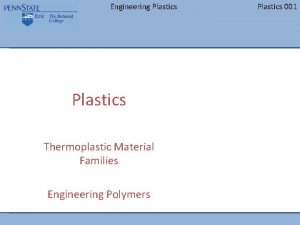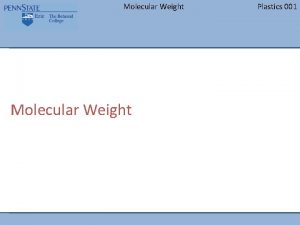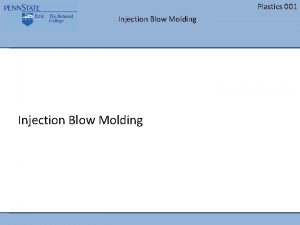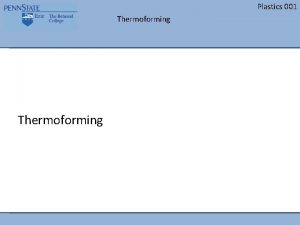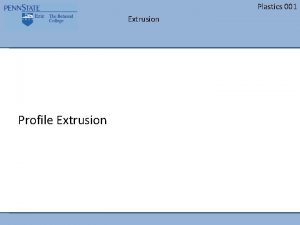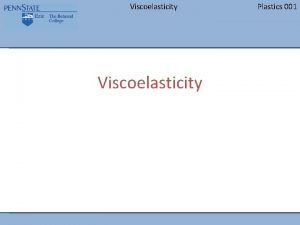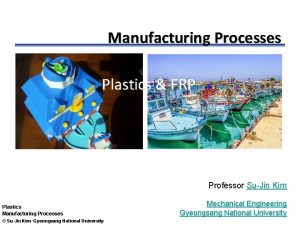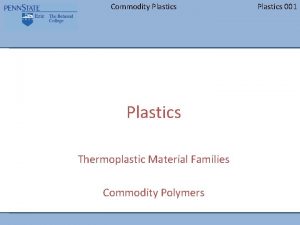LOW ENVIRONMENTAL IMPACT PLASTICS Prof MarcoAurelio De Paoli































- Slides: 31

LOW ENVIRONMENTAL IMPACT PLASTICS Prof. Marco-Aurelio De Paoli Universidade Estadual de Campinas (UNICAMP) - Brasil 2009

Post-doctoral work at MPI für Strahlenchemie, RFA, 1975 – 1977. Alexander von Humboldt Stiftung

Introduction Aims of our research: • Develop thermoplastic composites with adequate mechanical properties, reduced environmental impact and good cost/benefit ratio; use of renewable resources. • To replace short glass fibers in reinforced thermoplastics processed by injection molding; weight and environmental impact reduction.

Introduction “They (automobiles) will be lighter and much of them will be built of plastics developed from farm products”. Henry Ford, Ford from an article written by James Schweinehart published in The Detroit News of July, 30 rd, 1942.

Car parts made with natural fibers composite

Introduction Vegetal fibers can be used in substitution to fiber glass due to the following advantages: advantages • Produced from renewable resources. • Less abrasive to the processing equipments. • Lower density, producing lighter composites, • Better thermal and acoustic insulation, • Better surface finish in injection molded parts,

Introduction Vegetal fibers also present some challenges • Vegetal fibers decompose thermally above 220 o. C. • Like with fiberglass, composites cannot be mechanically recycled. They can be recycled only by pyrolysis (however, with carbon credits), • Vegetal fibers reinforced thermoplastics show higher flammability, thus, the use of a flame retardant is necessary. • Achieve a competitive cost in relation to synthetic fibers.

Introduction Why use Curauá fibers and not the market available vegetal fibers ? stress. , E e b specific for Curauá fibers Fiber dens. FC 1, 10 força máx / (MPa /g. cm-3) 636 -1000 E / (GPa cm 3/g) b / (% cm 3/g) 36 ± 10 3 ± 1 Specific density, stress, E and b for same reinforcing fibers* Density g/cm 3 / MPa /g. cm-3 E / GPa cm 3/g b / % cm 3/g cotton 1, 5 -1, 6 191 -398 3, 4 -7, 9 4, 7 -5, 0 Jute 1, 3 302 -595 20, 4 1, 2 -1, 4 Linho 1, 5 230 -790 18, 4 1, 8 -2, 1 Ramie 1, 5 270 -625 41 -85 2, 4 -2, 5 Sisal 1, 5 340 -416 6, 3 -14, 7 1, 3 -1, 7 glass (E)* 2, 5 800 -1400 28 1, 0 glass (S)** 2, 5 1800 34, 4 1, 1 Aramid 1, 4 2140 -2240 45 -48 2, 4 -2, 6 Carbon 1, 4 2860 164 -171 1, 0 -1, 3 fiber * Electric insulation, ** militar applications. *- from: A. K. Bledzki; J. Gassan. Composites reinforced with cellulose based fibres. Progres in Polymer Science 24 (1999) 221 -274.

Materials used üHDPE, Braskem, MFI = 7 g/10 min. üPP, Braskem, MFI = 10 g/10 min. üCurauá fibers, dryed and milled in a three knives rotary mill, Rone.

Processing equipment üCo-rotating interpenetrating twin-screw extruder, Werner-Pfleiderer ZSK-26, L = 1056, D = 24 mm, L/D = 44 (Fapesp 2004/15084 -6), SRS 250 – 500 rpm, side feeder 200 – 465 rpm. Main feeder side feeder üInjection molding Arburg All Rounder M-250 degasing

Processing equipment

Experimental: processing parameters HDPE matrix SRS* (rpm) Mass temperature (°C)** Pressure (bar) Torque (%) Output (kg/h) SME*** (Wh/kg) 250/200 136 -160 4 -19 33 -40 1. 9 1. 1 300/250 143 -164 4 -22 34 -38 2. 2 1. 1 350/300 140 -168 6 -16 30 -42 2. 4 1. 2 400/350 151 -172 5 -23 28 -41 3. 1 1. 0 500/450 145 -178 9 -14 32 -37 3. 5 1. 1 PP matrix 250/215 171 -195 7 -16 31 -41 2. 5 0, 8 300/265 177 -195 8 -16 30 -37 2. 6 0, 9 350/315 177 -199 7 -16 29 -34 2. 6 1, 0 400/365 175 -204 10 -16 27 -34 2. 9 1, 0 500/465 178 -202 10 -12 29 -37 3. 6 1, 0 *Main screws/side feeder screws ** polymer temperature near the dye *** Specific Mechanical Energy


HDPE matrix: effect of SR on fiber geometrical parameters Legend: pristine fiber ( ) and composites processed at ( ) 250, ( ) 300, ( ) 350 ( ), 400 and ( ) 500 rpm Above 350 rpm, aspect ratio decreases

HDPE-Fibrillation effect: MEV 50 μm 100 μm 6 μm

Matriz HDPE: mechanical properties 14% tensile 7% flexural 26% tensile Flexural n. v. 50% The yield stress and Young’s Modulus show a decreasing tendency, in accordance with the decrease in the fiber aspect ratio. The elongation at break increases due to the decline in the reinforcement effect.

HDPE Tensile mechanical tests - ASTM D-638 Formulação em wt % smáx. /r (MPa. g/cm 3) smáx. (MPa) E (MPa)/r (MPa. g/cm 3) E (MPa) (%)/r e (%) HDPE 17. 8 ± 0. 1 1358 ± 152 < 100 HDPE/20%FC 28. 4 ± 0. 2 28. 1 ± 0. 2 2501 ± 447 2471 ± 447 3. 7 ± 0. 1 HDPE/20%FC/ 2%PEAM 30. 7 ± 0. 3 30. 3 ± 0. 3 2763 ± 294 2730 ± 294 3. 2 ± 0. 5 HDPE/30%FV* 42 - 51 52 - 63 3952 - 5080 4900 - 6300 1. 2 - 2. 0 1. 5 - 2. 5 d. CFC = 0. 988 ± 0. 04 g/ cm 3 (15, 7 % em volume) d. CFV = 1. 2 - 1. 28 g/ cm 3 ( 1, 27 g/cm 3 com 15 % em volume) *PE 30 % GF – Polyethylene 30 % Glass fiber ®, Omnexus, United States, 2007.

HDPE Flexural mechanical tests ASTM D-790 Formulação em wt % smáx. /r (MPa. g/cm 3) smáx. (MPa) E (MPa)/r (MPa. g/cm 3) E (MPa) HDPE 20. 9 ± 0. 5 888 ± 43 HDPE/20%FC 37. 5 ± 0. 3 37. 1 ± 0. 3 1609 ± 98 1590 ± 98 HDPE/20%FC/ 2%PEAM 41. 4 ± 0. 3 40. 9 ± 0. 3 1983 ± 129 1959 ± 129 HDPE/30%FV* 42 - 51 52 - 63 3952 - 4516 4900 - 5600 d. CFC = 0. 988 ± 0. 04 g/ cm 3 (15, 7 % em volume) d. CFV = 1. 2 - 1. 28 g/ cm 3 ( 1, 27 g/cm 3 com 15 % em volume) *PE 30 % GF – Polyethylene 30 % Glass fiber ®, Omnexus, United States, 2007

HDPE Impact resistence ASTM D-256 Formulação em wt % Resistência ao Impacto Izod (J. g/cm 3) (J/m) Resistencia ao Impacto Charpy (k. J/m 2) HDPE 82. 3 ± 6. 4 3. 5 ± 0. 1 HDPE/20%FC 62. 8 ± 2. 9 62. 0 ± 2. 9 3. 5 ± 0. 4 HDPE/20%FC/ 2%PEAM 66. 0 ± 3. 9 65. 2 ± 3. 9 3. 4 ± 0. 2 HDPE/30%FV* 48 - 64 60 -80 - d. CFC = 0. 988 ± 0. 04 g/ cm 3 (15, 7 % em volume) d. CFV = 1. 2 - 1. 28 g/ cm 3 ( 1, 27 g/cm 3 com 15 % em volume) *PE 30 % GF – Polyethylene 30 % Glass fiber ®, Omnexus, United States, 2007


PP matrix: effect of SR on fiber geometrical parameters Legend: pristine fiber ( ) and composites processed at ( ) 250, ( ) 300, ( ) 350 ( ), 400 and ( ) 500 rpm Changes in aspect ratio with screw rotation

PP-Fibrillation effect: MEV

PP matrix: mechanical properties 12. 5% tensile flexural n. v. 32% Tensile yield stress and Young Modulus show a decreasing tendency, in accordance with the variation in the fiber aspect ratio. The elongation at break increases due to the decline in the reinforcement effect.

PP Mechanical tensile tests, ASTM D-638 Formulação em wt % σmáx. /d (MPa/g cm -3) σ máx. (MPa) E (MPa)/d (GPa. g/cm 3) E (MPa) (%)/d e (%) PP 27, 2 ± 0, 5 1736 ± 112 > 300 PP/20%FC 32, 3 ± 0, 2 31, 4 ± 0, 5 2870 ± 254 2790 ± 254 1, 9 ± 0, 2 1, 8 ± 0, 2 PP/20%FC/2%PPA M 39 ± 0, 2 38 ± 0, 2 3393 ± 357 3298 ± 357 2, 2 ± 0, 3 2, 1 ± 0, 3 PP/20%FV* 43 45 3810 4000** 4, 8 5 d. CFC = 0, 972 ± 0, 010 g/ cm 3 (15 % em volume) d. CFV = 1, 05 g/ cm 3 (1, 14 g/cm 3 com 8 % em volume) * PP com 20 wt% de FV – Petrotene PH 304, Petropol Polímeros ** Polypropylene/ 20 % Glass fibre ®, Omnexus, United States, 2007

PP Flexural mechanical tests, ASTM D-790 Formulação em wt % smáx. /r (MPa/g/cm 3) smáx. (MPa) E (MPa)/r (MPa/g/cm 3) E (MPa) PP 37, 1 ± 1, 4 1046 ± 59 PP/20%FC 51 ± 1 50 ± 1 2187 ± 100 2126 ± 100 PP/20%FC/2%PPAM 58 ± 1 56 ± 1 1913 ± 214 1859 ± 214 PP/20%FV* 76 80 3000 d. CFC = 0, 972 ± 0, 010 g/ cm 3 (15 % em volume) d. CFV = 1, 05 g/ cm 3 (1, 14 g/cm 3 com 8 % em volume) * PP com 20 wt% de FV – Petrotene PH 304, Petropol Polímeros

PP Impact resistence tests, ASTM D-256 Formulação em wt % Resistência ao Impacto Izod (J/g/cm 3) (J/m) Resistência ao Impacto Charpy (k. J/m 2) PP 17, 3 ± 4, 43 1, 6 ± 0, 2 PP/20%FC 28 ± 9 27 ± 9 3, 3 ± 0, 6 PP/20%FC/2%PPAM 29 ± 3 28 ± 3 2, 6± 0, 3 PP/20%FV* 52 55 - d. CFC = 0, 972 ± 0, 010 g/ cm 3 (15 % em volume) d. CFV = 1, 05 g/ cm 3 (1, 14 g/cm 3 com 8 % em volume) * PP com 20 wt% de FV – Petrotene PH 304, Petropol Polímeros

Car parts made with Nylon-6/curauá fibers composite Developed under contract with Sabic Innovative Plastics

Car parts made with Nylon-6/curauá fibers composite Developed under contract with Sabic Innovative Plastics

CONCLUSIONS • Aspect ratio of the fibers in the injection molded samples is affected by the processing conditions in the extruder. • For both polymers, the mechanical properties are affected by the fiber aspect ratio variation. • HDPE is more affected than PP by the processing conditions. • Final mechanical properties depend on the correct choice of processing conditions.

Research group • • • MSc, Bárbara Mano, MSc, Joyce Araújo, Vanessa S de Oliveira Prof. Dr. Márcia AS Spinacé Léa Garcia Janeiro Filippe Bernardino Thais Grossi MSc, Paulo Santos (SABIC) Karen Fermoselli (SABIC/Unicamp) Prof. Dr. Walter R Waldman (UENF)

ACKNOWLEDGEMENTS Procs. 04/15084 -6, 06/58342 -0, 06/58343 -7, 08/06503 -6 e 08/06506 -8.
 Jean pierre paoli
Jean pierre paoli Institut paoli calmettes
Institut paoli calmettes 10 degree blood drop
10 degree blood drop Low impact living affordable community
Low impact living affordable community Freight villages
Freight villages Low impact for beginners
Low impact for beginners Low impact development
Low impact development Low impact development
Low impact development Low accuracy low precision
Low accuracy low precision Low voltage hazards
Low voltage hazards Mid = low + (high - low) / 2
Mid = low + (high - low) / 2 What is communication style bias?
What is communication style bias? Environmental impact of cnc machining
Environmental impact of cnc machining Agent orange function
Agent orange function Ipat model of environmental impact
Ipat model of environmental impact Rapid environmental impact assessment in disaster
Rapid environmental impact assessment in disaster Ipat model of environmental impact
Ipat model of environmental impact Eia meaning
Eia meaning Sustainable engineering ktu
Sustainable engineering ktu Ipat model of environmental impact
Ipat model of environmental impact Importance of baseline data
Importance of baseline data Environmental science sustaining your world
Environmental science sustaining your world Environmental impact of tidal energy
Environmental impact of tidal energy Mh 605
Mh 605 Maico plastics
Maico plastics Moretto plastics automation
Moretto plastics automation What is a cantilever snap joint
What is a cantilever snap joint Plastics
Plastics Placsis
Placsis Advantages of calendering
Advantages of calendering Phillips plastics corp
Phillips plastics corp Why do different polymers have different properties
Why do different polymers have different properties
